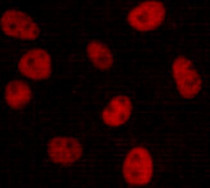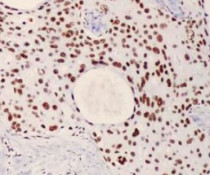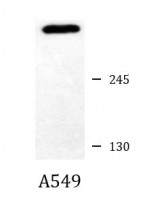ARG54084
anti-DNA PKcs antibody
anti-DNA PKcs antibody for ICC/IF,IHC-Formalin-fixed paraffin-embedded sections,Immunoprecipitation,Western blot and Human
Gene Regulation antibody
Overview
| Product Description | Mouse Monoclonal antibody recognizes DNA PKcs |
|---|---|
| Tested Reactivity | Hu |
| Tested Application | ICC/IF, IHC-P, IP, WB |
| Host | Mouse |
| Clonality | Monoclonal |
| Isotype | IgG1 |
| Target Name | DNA PKcs |
| Antigen Species | Human |
| Immunogen | Purified recombinant human DNA-PKcs protein fragments expressed in E.coli |
| Conjugation | Un-conjugated |
| Alternate Names | p350; DNAPK; HYRC1; DNA-PKcs; DNA-dependent protein kinase catalytic subunit; DNPK1; IMD26; HYRC; EC 2.7.11.1; p460; DNA-PK catalytic subunit; XRCC7 |
Application Instructions
| Application Suggestion |
|
||||||||||
|---|---|---|---|---|---|---|---|---|---|---|---|
| Application Note | IHC-P: Antigen Retrieval: Boil tissue section in Citrate buffer (pH 6.0). * The dilutions indicate recommended starting dilutions and the optimal dilutions or concentrations should be determined by the scientist. |
Properties
| Form | Liquid |
|---|---|
| Purification | Affinity purified |
| Buffer | PBS (pH 7.4), 0.2% Sodium azide, 0.1% BSA and 50% Glycerol |
| Preservative | 0.2% Sodium azide |
| Stabilizer | 0.1% BSA and 50% Glycerol |
| Concentration | Lot dependent |
| Storage Instruction | For continuous use, store undiluted antibody at 2-8°C for up to a week. For long-term storage, aliquot and store at -20°C. Storage in frost free freezers is not recommended. Avoid repeated freeze/thaw cycles. Suggest spin the vial prior to opening. The antibody solution should be gently mixed before use. |
| Note | For laboratory research only, not for drug, diagnostic or other use. |
Bioinformation
| Database Links |
Swiss-port # P78527 Human DNA-dependent protein kinase catalytic subunit |
|---|---|
| Gene Symbol | PRKDC |
| Gene Full Name | protein kinase, DNA-activated, catalytic polypeptide |
| Background | Serine/threonine-protein kinase that acts as a molecular sensor for DNA damage.Involved in DNA nonhomologous end joining(NHEJ)required for double-strand break(DSB)repair and V(D)J recombination.Must be bound to DNA to express its catalytic properties.Promotes processing of hairpin DNA structures in V(D)J recombination by activation of the hairpin endonuclease artemis(DCLRE1C).The assembly of the DNA-PK complex at DNA ends is also required for the NHEJ ligation step.Required to protect and align broken ends of DNA.May also act as a scaffold protein to aid the localization of DNA repair proteins to the site of damage.Found at the ends of chromosomes,suggesting a further role in the maintenance of telomeric stability and the prevention of chromosomal end fusion.Also involved in modulation of transcription.Recognizes the substrate consensus sequence[ST]-Q.Phosphorylates'Ser-139' of histone variant H2AX/H2AFX,thereby regulating DNA damage response mechanism.Phosphorylates DCLRE1C,c-Abl/ABL1,histone H1,HSPCA,c-jun/JUN,p53/TP53, PARP1, POU2F1,DHX9,SRF,XRCC1,XRCC1,XRCC4,XRCC5,XRCC6,WRN,MYC and RFA2.Can phosphorylate C1D not only in the presence of linear DNA but also in the presence of supercoiled DNA.Ability to phosphorylate p53/TP53 in the presence of supercoiled DNA is dependent on C1D. |
| Function | Serine/threonine-protein kinase that acts as a molecular sensor for DNA damage. Involved in DNA non-homologous end joining (NHEJ) required for double-strand break (DSB) repair and V(D)J recombination. Must be bound to DNA to express its catalytic properties. Promotes processing of hairpin DNA structures in V(D)J recombination by activation of the hairpin endonuclease artemis (DCLRE1C). The assembly of the DNA-PK complex at DNA ends is also required for the NHEJ ligation step. Required to protect and align broken ends of DNA. May also act as a scaffold protein to aid the localization of DNA repair proteins to the site of damage. Found at the ends of chromosomes, suggesting a further role in the maintenance of telomeric stability and the prevention of chromosomal end fusion. Also involved in modulation of transcription. Recognizes the substrate consensus sequence [ST]-Q. Phosphorylates 'Ser-139' of histone variant H2AX/H2AFX, thereby regulating DNA damage response mechanism. Phosphorylates DCLRE1C, c-Abl/ABL1, histone H1, HSPCA, c-jun/JUN, p53/TP53, PARP1, POU2F1, DHX9, SRF, XRCC1, XRCC1, XRCC4, XRCC5, XRCC6, WRN, MYC and RFA2. Can phosphorylate C1D not only in the presence of linear DNA but also in the presence of supercoiled DNA. Ability to phosphorylate p53/TP53 in the presence of supercoiled DNA is dependent on C1D. Contributes to the determination of the circadian period length by antagonizing phosphorylation of CRY1 'Ser-588' and increasing CRY1 protein stability, most likely through an indirect machanism. Interacts with CRY1 and CRY2; negatively regulates CRY1 phosphorylation. [UniProt] |
| Cellular Localization | Nucleus. |
| Research Area | Gene Regulation antibody |
| Calculated MW | 469 kDa |
| PTM | Autophosphorylated on Ser-2056, Thr-2609, Thr-2638 and Thr-2647. Ser-2056 and Thr-2609 are DNA damage-inducible phosphorylation sites (inducible with ionizing radiation, IR) dephosphorylated by PPP5C. Autophosphorylation induces a conformational change that leads to remodeling of the DNA-PK complex, requisite for efficient end processing and DNA repair. S-nitrosylated by GAPDH. Polyubiquitinated by RNF144A, leading to proteasomal degradation. |
Images (4) Click the Picture to Zoom In
-
ARG54084 anti-DNA PKcs antibody ICC/IF image
Immunofluorescence: HeLa cells stained with ARG54084 anti-DNA PKcs antibody at 1:100 dilution.
-
ARG54084 anti-DNA PKcs antibody IHC-P image
Immunohistochemistry: Paraffin-embedded breast cancer tissue stained with ARG54084 anti-DNA PKcs antibody at 1:200 dilution. Antigen Retrieval: Boil tissue section in Citrate buffer (pH 6.0).
-
ARG54084 anti-DNA PKcs antibody WB image
Western blot: A549 cell lysate stained with ARG54084 anti-DNA PKcs antibody at 1:1000 dilution.
-
ARG54084 anti-DNA PKcs antibody IP image
Immunoprecipitation: HeLa cell lysates were immunoprecipitated and stained with ARG54084 anti-DNA PKcs antibody.









